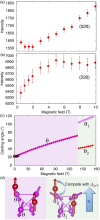Magnetic Frustration Driven by Itinerancy in Spinel CoV2O4
- PMID: 29215077
- PMCID: PMC5719412
- DOI: 10.1038/s41598-017-17160-0
Magnetic Frustration Driven by Itinerancy in Spinel CoV2O4
Abstract
Localized spins and itinerant electrons rarely coexist in geometrically-frustrated spinel lattices. They exhibit a complex interplay between localized spins and itinerant electrons. In this paper, we study the origin of the unusual spin structure of the spinel CoV2O4, which stands at the crossover from insulating to itinerant behavior using the first principle calculation and neutron diffraction measurement. In contrast to the expected paramagnetism, localized spins supported by enhanced exchange couplings are frustrated by the effects of delocalized electrons. This frustration produces a non-collinear spin state even without orbital orderings and may be responsible for macroscopic spin-glass behavior. Competing phases can be uncovered by external perturbations such as pressure or magnetic field, which enhances the frustration.
Conflict of interest statement
The authors declare that they have no competing interests.
Figures





References
-
- Moessner R, Chalker JT. Properties of a Classical Spin Liquid: The Heisenberg Pyrochlore Antiferromagnet. Phys. Rev. Lett. 1998;80:2929. doi: 10.1103/PhysRevLett.80.2929. - DOI
-
- Lacroix, C., Mendels, P., & Mila, F. Introduction to Frustrated Magnetism: Materials, Experiments, Theory. Springer (2001).
Publication types
LinkOut - more resources
Full Text Sources
Other Literature Sources

